Sarpsborg 08 have a new and conflicting history. The Norwegian city has been home to multiple struggling clubs in years before 2008. However, after rivalries were ended and all the clubs united to form one stronger team, Sarpsborg has been able to strengthen year by year.
The progress saw them reach Norway’s top flight, Eliteserien, in 2017 and become a regular in the division. Their steep rise even saw them reach the UEFA Europa League in their first season in the top flight, where they faced Besiktas, Malmo, and Genk before being eliminated.
Stefan Billborn’s side has stood out this season for their intriguing corner routines. Three months into the season, after 14 league games and numerous cup games, I have decided to watch all 130 corners they have taken this season, specifically the most recent 107, after adopting this new strategy, and analyse whether Sarpsborg’s corner strategy is effective or not.
In this tactical analysis, we will look into the tactics behind Sarpsborg 08’s corner routines, with an in-depth analysis of how their strategy of crowding the six-yard box has been successful. This set-piece analysis will examine why this method has been particularly effective and how Sarpsborg can build on a solid base to develop their unique approach further.
Six-Yard Box Suffocation
To begin the season, Sarspborg’s starting positions were spread out around the box, and players would attack the ball from different directions. However, after a clear preference to target the six-yard box and an unsuccessful original routine where players failed to make the first contact, Sarpsborg had to amend their routine.
To make life easier for each attacker, they altered the starting positions, placing each attacking member of the team inside the six-yard box, where the ball would come to them, rather than attackers meeting the cross along its path. By crowding the six-yard box, Sarpsborg found instant success for various reasons.
Firstly, their ability to position their attackers by the back post helped to increase the likelihood of making the first contact. Having players situated by the back post makes it more challenging for defenders to track both the ball and the attacker. As the cross is delivered, defenders begin to track the flight of the ball, which provides the Sarpsborg attacker in the image below to create some separation from his marker, which allows him to attack the cross unopposed.
Attacking the ball without anyone interrupting the approach to the ball means that the attacker can time the jump and run up, to meet the ball at the optimal position, increasing the likelihood of winning the aerial duel. This is already an instant upgrade on their previous methods; by increasing the number of times a Sarpsborg player meets the cross, the rate of shots from corners shot up.
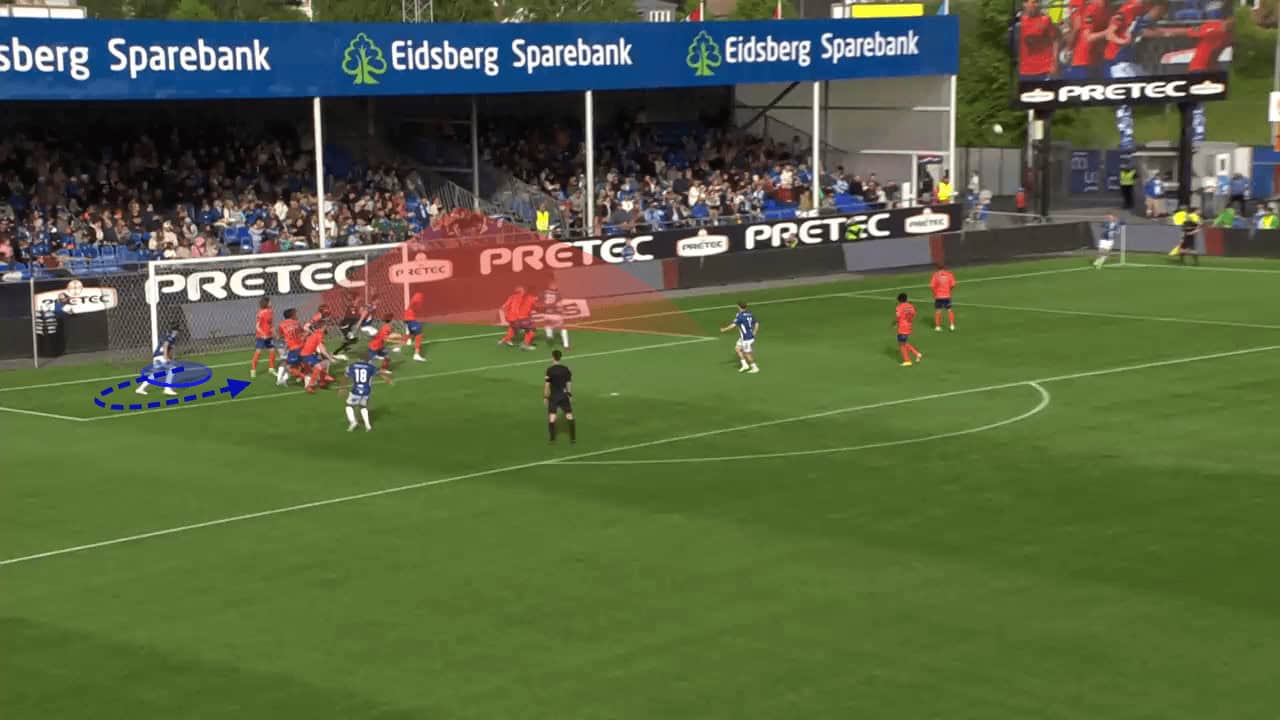
Furthermore, crowding the six-yard box enabled Sarpsborg to regularly create overloads in dangerous positions. In the early stages of this routine, opposition teams weren’t able to prepare well, and so there were occasions where a player at the back post could lurk unmarked. This provided the perfect opportunity for a player to have a free shot on goal from within six yards, which Sarpsborg capitalised on in this example below.
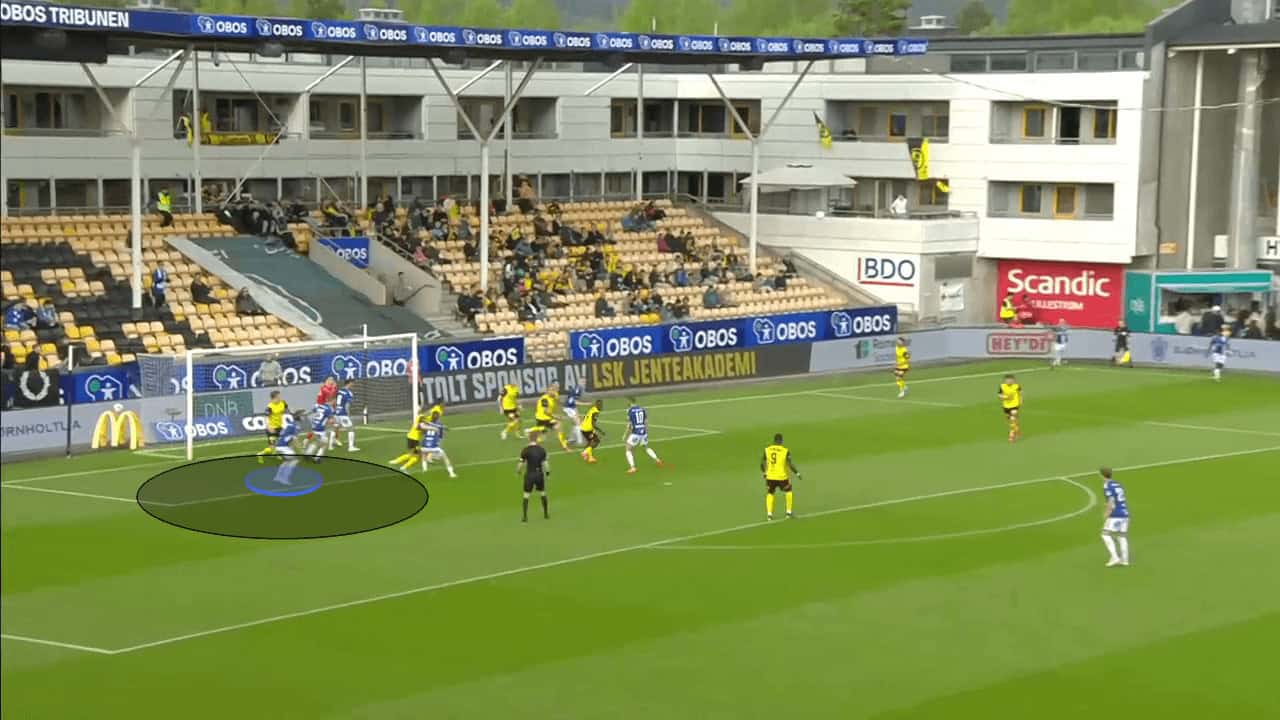
A key benefit of positioning players so close to the goal and by the back post is that defenders have trouble tracking both the ball and attacker simultaneously, as stated before. Earlier, we explained how individual defenders are weakened by the inability to track the ball and player simultaneously. However, the effects are multiplied when the numbers increase. Each defender can only do half a job, whilst attackers are able to coordinate moves in unison to create further problems.
In the example below, we can see a 2v2 at the back post. While the defending team is numerically safe, they are extremely vulnerable to attacking moves like screens or decoy runs due to the reasons stated earlier. As the corner is taken, both defenders begin to focus on the ball, which is the trigger for the attacking team to carry out their plan. One attacker, whose marker is now focused on the ball, can be seen moving toward a different attacker’s marker to set a screen. This gives the second attacker the opportunity to move away from his marker into space.
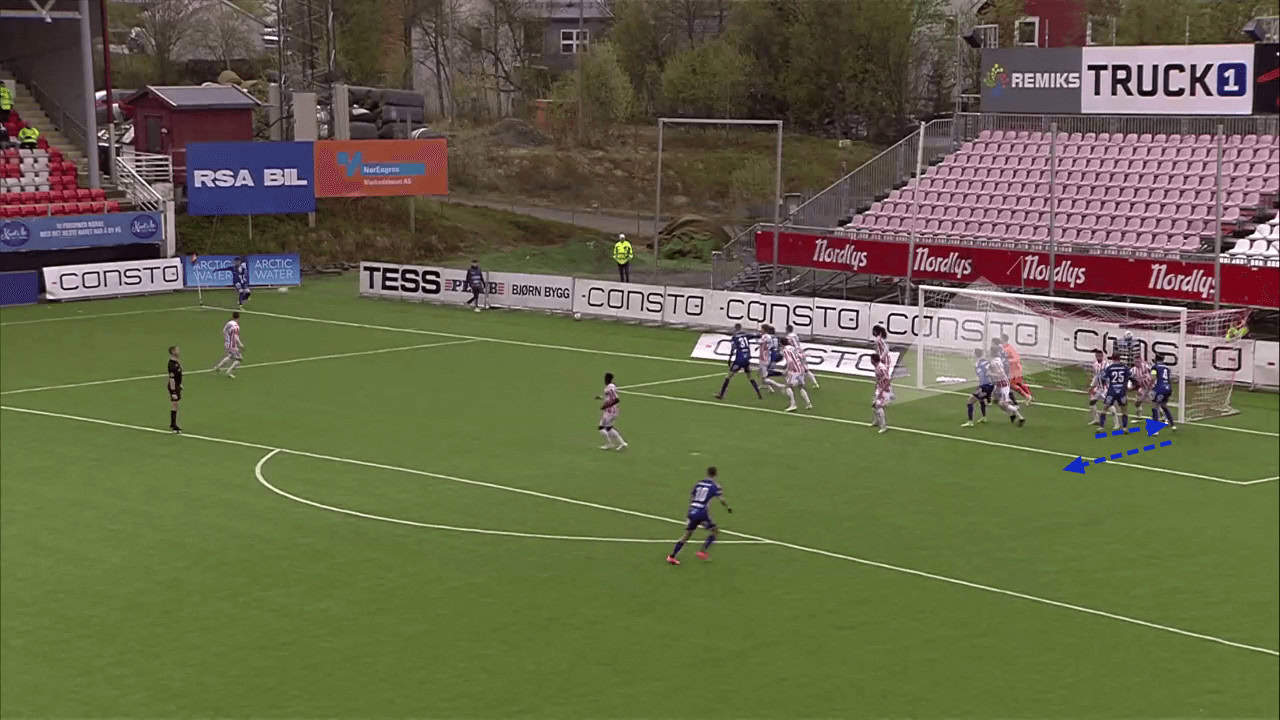
Even with constant communication between the two defenders, the separation has already been created due to the coordinated movements of the attackers, leaving the defenders exposed and unable to prevent the attacker from attacking the ball freely. These types of moves can be carried out within a couple of seconds, where defenders don’t have the time to react and decide their next moves. Mistakes are more likely to be made in split-second moments, leaving the attacking team with the advantage.
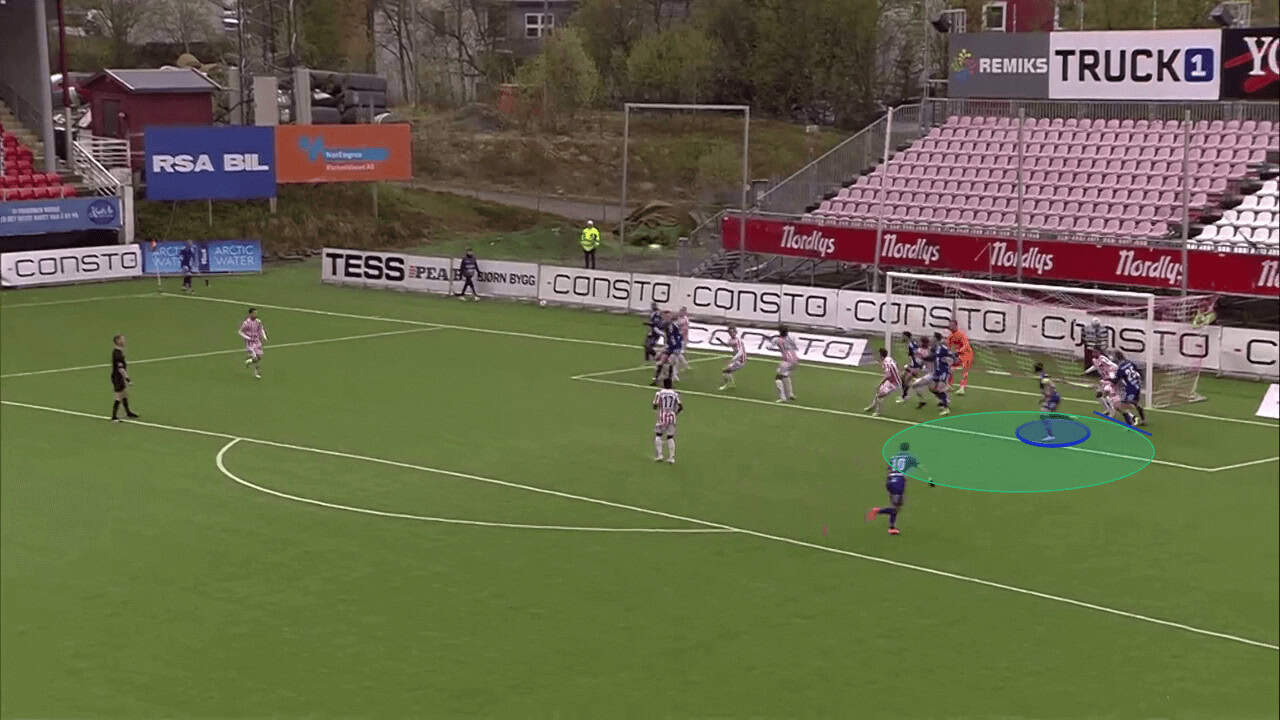
Added Benefits
Crowding the six-yard box also forces the defensive team to set up camp inside their own six-yard box, leading to further advantages for the attacking side. As shown by the two solid white lines in the image below, the goalkeeper is usually restricted to a tiny area where he can operate.
An opposition player marking the goalkeeper can cut off his ability to step out and claim the ball, whilst the big clusters of players inside the six-yard box trap the goalkeeper from escaping even if he bypasses the first marker. The ability to prevent the goalkeeper from claiming the ball allows Sarpsborg to cross the ball into the six-yard box regularly, from where minimal contact is required to result in a goal.
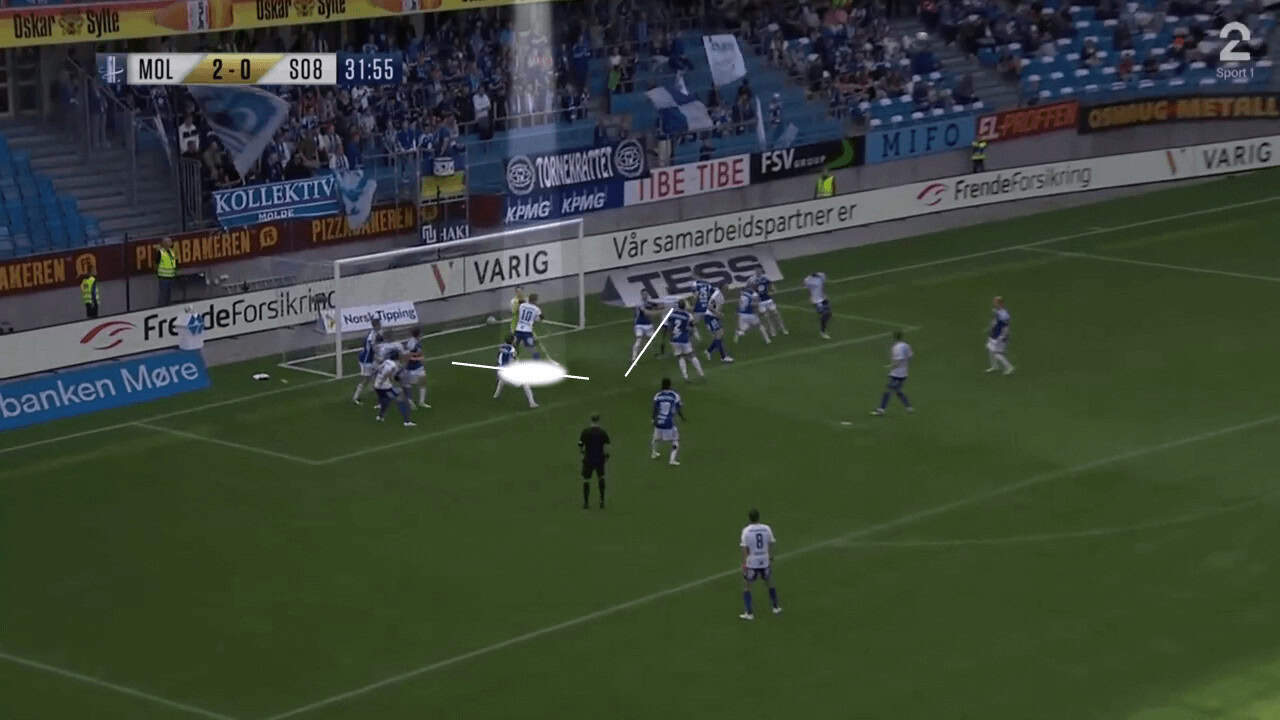
In addition to the limited goalkeeper’s movement, the entire defensive unit is also limited when defending these types of corners. As each defender has to remain goal side to prevent an easy header from being scored, Sarpsborg are able to trap and suffocate teams inside the six-yard box, which provides large amounts of space in the area between the six-yard line and 18-yard line.
When the space available is so vast, all that an attacker has to do is time their run to arrive in the green area as the ball arrives there to gain an unopposed shot on goal from close range. Although the space is available regularly, this is an area that Sarpsborg have failed to target through the use of deep runs and is something that can help them rise to a higher level as a set piece unit.
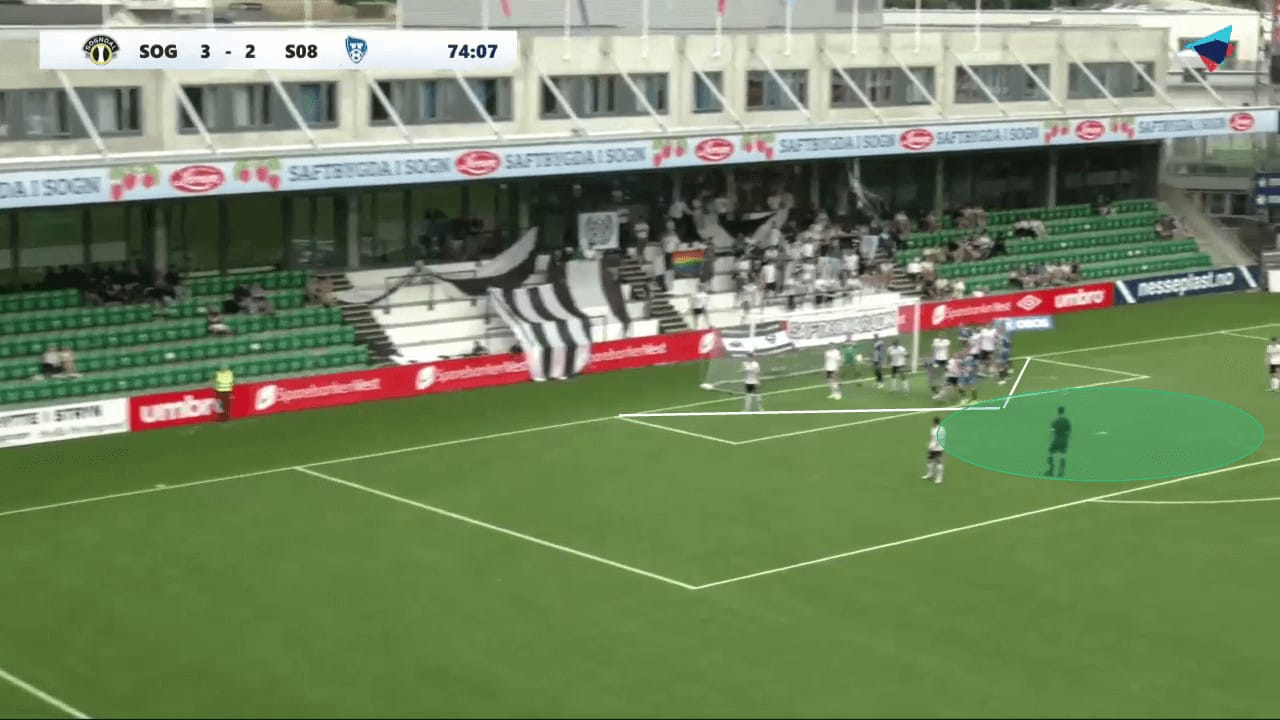
As mentioned above, Sarpsborg have been able to trap teams inside their own six-yard box through their methods of crowding the six-yard box. This high positioning gives Sarpsborg the opportunity for second chances from corner kicks, even when the delivery is inaccurate at times.
When a cross comes in behind everyone, going through the blue corridor pictured below, the Sarpsborg players can create multiple screens to create that corridor and prevent any opposition defender from stepping out to clear the ball. Once the ball comes out through the other side of that corridor, the deepest attacker then has the time to react to the flight of the ball and move into its path to have an unopposed shot on goal. This strategy can be effective, but it is reliant on every Sarpsborg attacker working in unison to form screens and prevent every defender from stepping up to clear the ball.

At times, opposition defenders have attempted to ‘cheat’ by ignoring the principle of remaining goal side of their marker to get into the open corridor early. This is common after the above routine comes off, and defenders know the threat. In the cases where defenders have cheated, the Sarpsborg attackers have been able to think quickly on their feet by performing goal-side screens, where they simultaneously prevent their marker from coming back goal side whilst also attempting to redirect the ball goalwards.
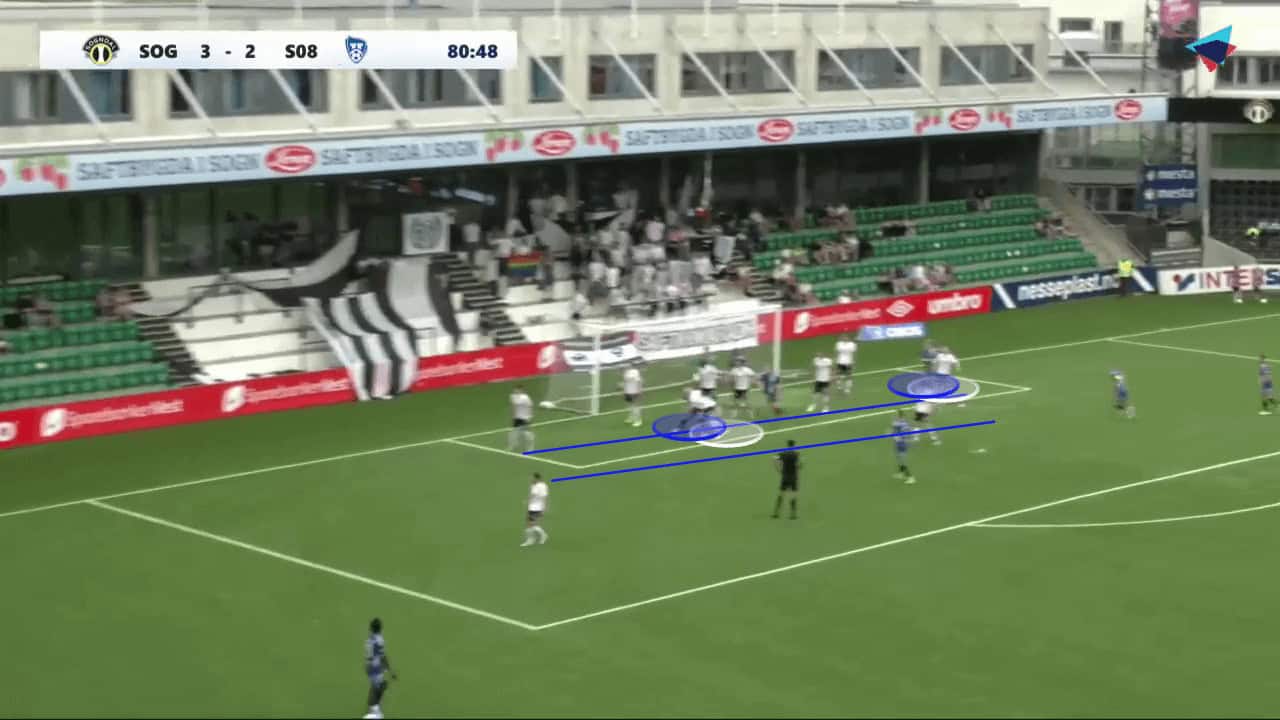
Second Phase Danger
Another benefit of forcing the defending team to sit deep inside their own six-yard box is that it becomes easier to sustain pressure on second balls. When the first contact is made, usually at the back post, the defending team will usually have around eight players inside their own six-yard box.
As a result, there is hardly anyone available to collect the ball and take it away from danger should the defensive side make the first contact. This means that even if the defensive side is able to defend the first ball, they will remain vulnerable, as Sarpsborg attackers will be more likely to get to the clearance, and put the ball back into the danger zone.
The example below illustrates the defending team being able to clear the ball slightly away from their goal, but ultimately the ball lands at a different attacker’s feet, and they can sustain the pressure by taking an unopposed shot from the penalty spot.
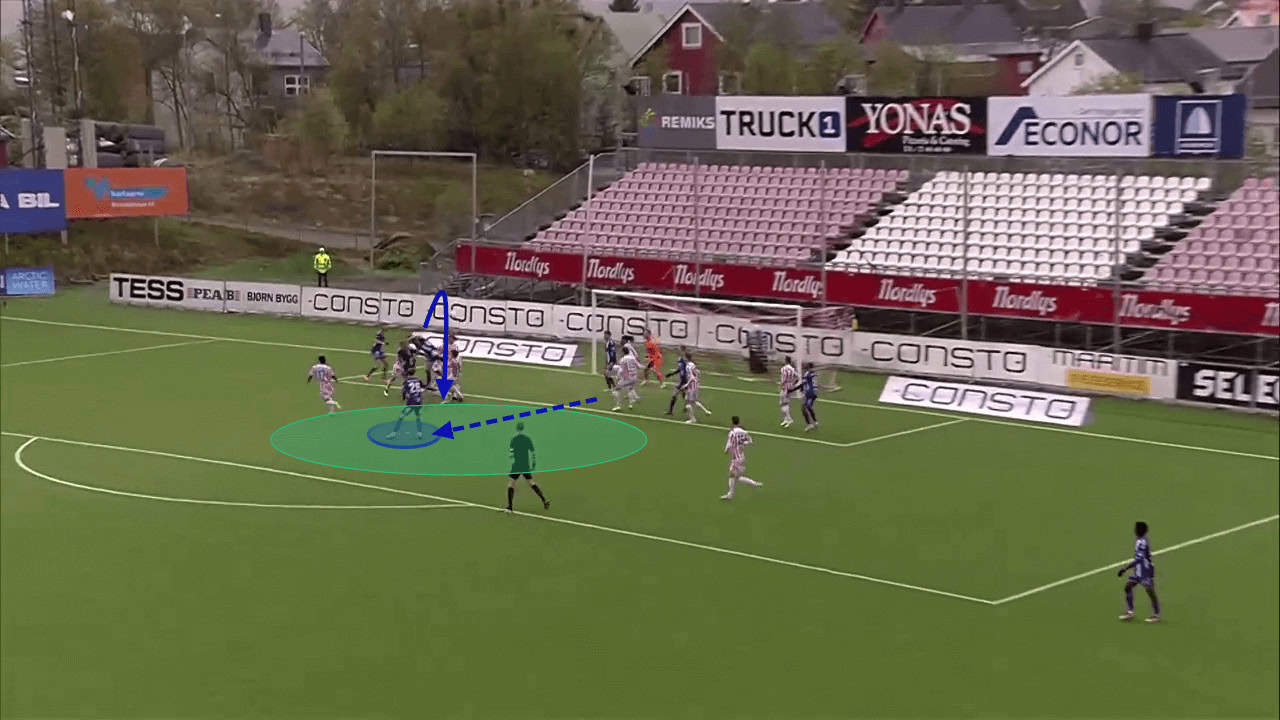
Another way Sarpsborg can cause a threat during second balls is by maintaining a heavy presence inside the six-yard box. The above example showed what happens if an opposition player makes the first contact. However, the attacking player has an equally good opportunity of making the first contact.
In the cases where the ball is too far from goal to shoot directly, the players will attempt to keep the chance alive by heading it back across the six-yard box, where the heavy presence of Sarpsborg attackers remains. The example below shows three separate attackers all waiting for the ball back into the six-yard box after the original cross has been overhit, who then combine to put the ball into the back of the net.
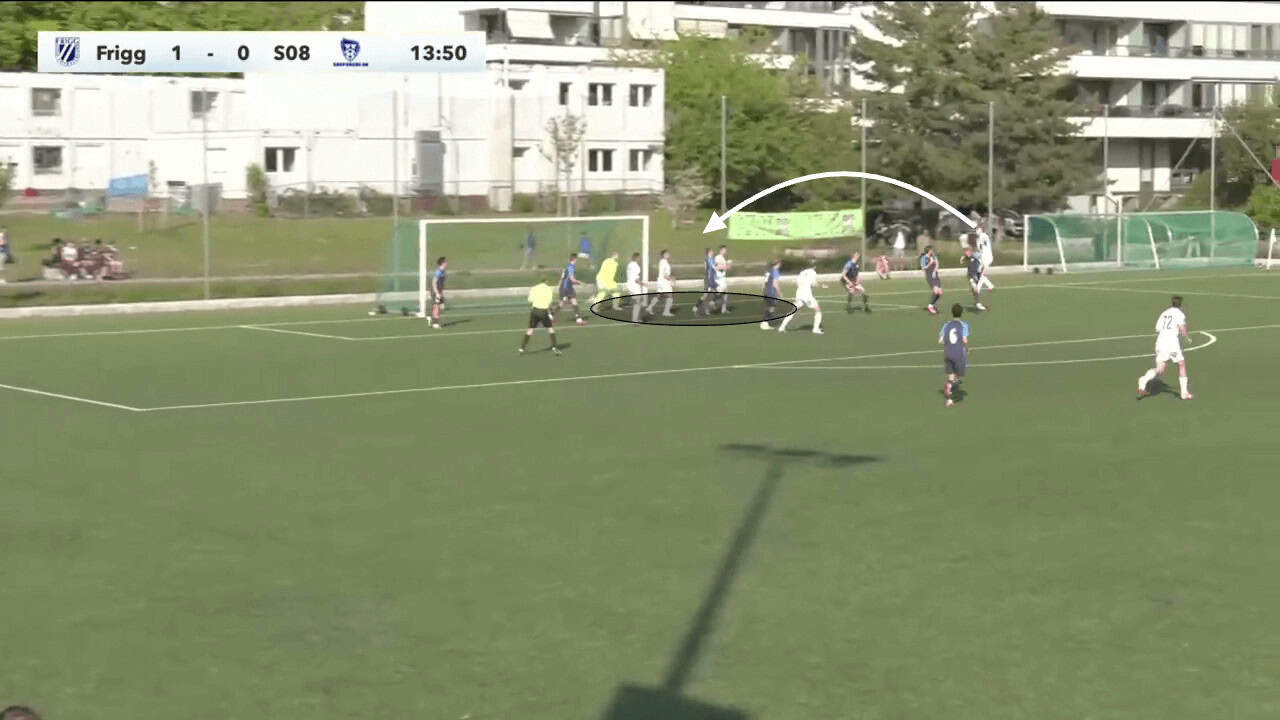
Exploring the Need for Variations
Whilst these routines explained earlier have proven effective, the overreliance on the back post has made Sarpsborg too predictable. Defensive sides are able to outnumber the attackers in that area. Each defender can man-mark an attacker to prevent them from getting the separation to attack the ball, while a spare zonal marker is free to attack and clear the ball. This allows them to remain secure without worrying about other areas of the box, as Sarpsborg have been reluctant to venture out.
On the odd occasion, Sarpsborg have varied the corners and have seen success off the back of these variations, which should encourage them to remain brave and attempt different variations. In this example below, by luring defenders towards the back post, Sarpsborg could create lots of space at the near side of the six-yard box.
This space was then attacked by the highlighted attacker, who came in from the defenders’ blind side, where they couldn’t track the run as they weren’t aware of his move until it was too late, and the separation was created. The timing of the run was perfect, so he could come out into the space as the ball arrived, meaning no defender was there waiting for the ball to clear it.
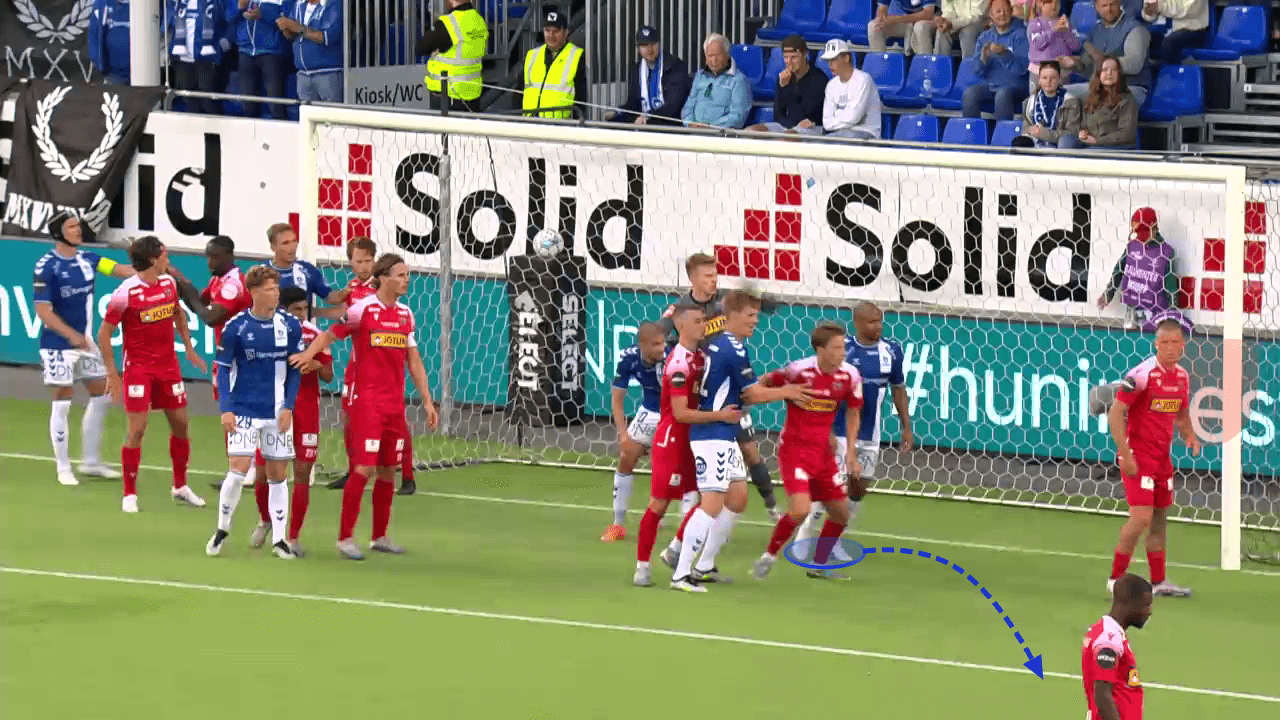
Another slight variation of this routine has been to create decoy movements towards the near side of the six-yard box, where defenders are then dragged away from the back post, and a runner from deep can attack the space created. This is another excellent variation, where defenders can get complacent and think a particular part of the box is safe before a run from deep penetrates that space.
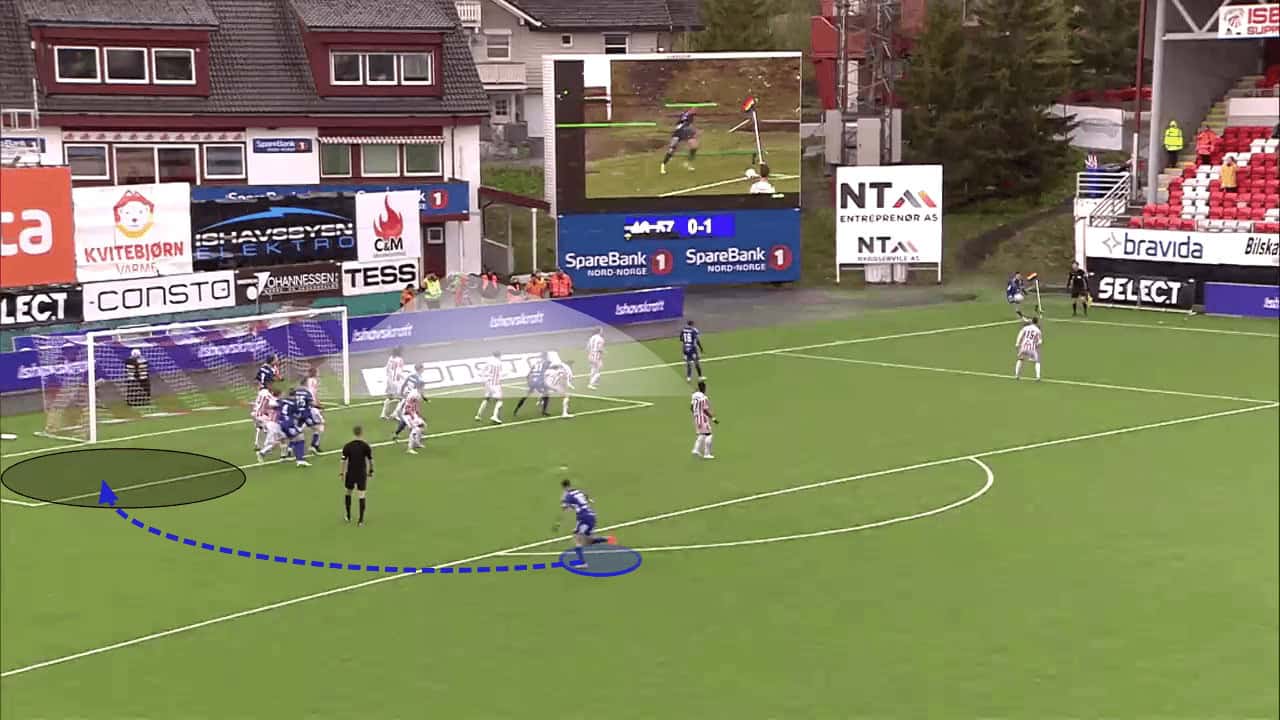
One issue that Sarpsborg have consistently come across in the 100+ corners they have attempted when crowding the six-yard box is the lack of unity in their attack. In most of their corners, it doesn’t look like the players are on the same wavelength, and every player is out to score for themselves. Whilst having multiple targets can be seen as a benefit for specific teams, their inability to effectively work together means no attacker can gain a significant advantage in the aerial duel.
This may be ok when teams have multiple aerial specialists. However, this is not the case for Sarpsborg. Players struggle to gain that crucial advantage of creating separation, meaning each player is left in a fair aerial duel, which Sarpsborg haven’t been particularly effective in.
In this example below, we can see two players attempting to anchor in front of their marker to create the space in front of them to attack the aerial duel, whilst another attacker was blocking his marker and the goalkeeper from stepping away from the goal and created the space on the edge of the six-yard box.
A lack of cohesion results in many of these scenarios, where certain players’ roles become ineffective as the ball isn’t targeted towards them, and they could be performing a screen or decoy run in the target area, helping their teammate to get more space to attack the ball with.
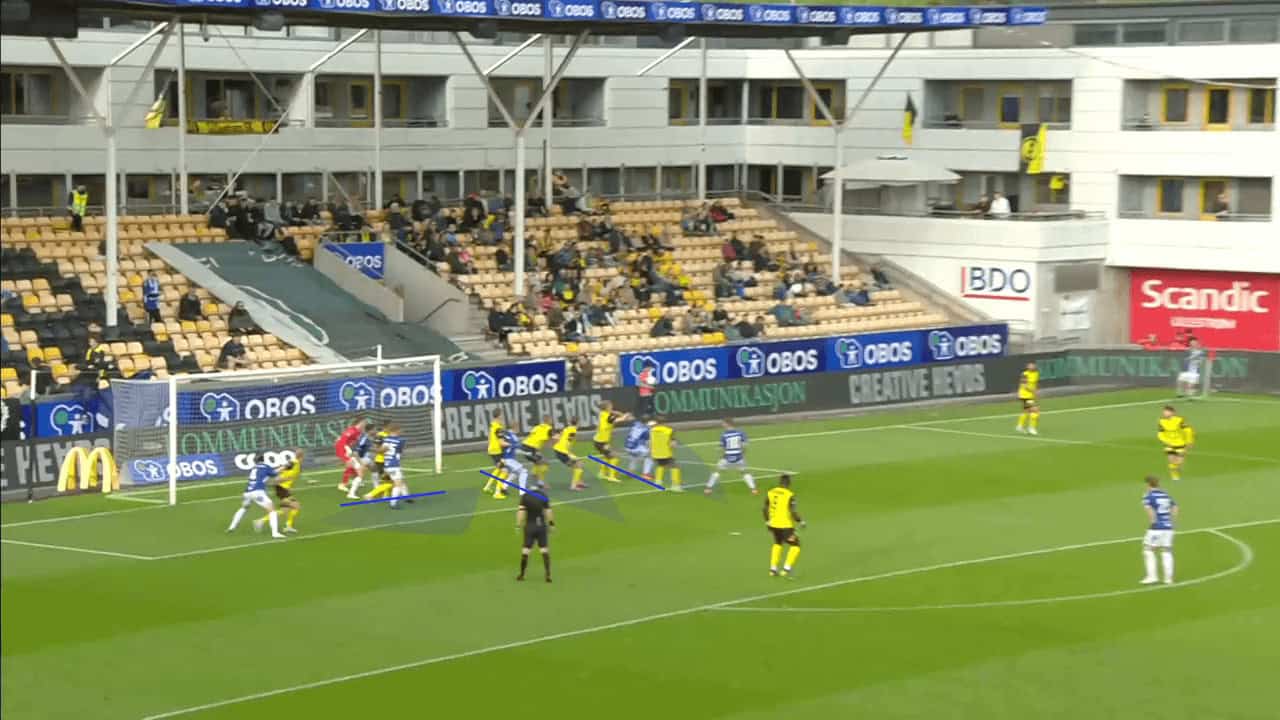
Summary
This tactical analysis has detailed the numerous different ways in which Sarpsborg 08 have been able to threaten other Eliteserien sides through their strategy to crowd the six-yard box.
While many of these corners have been successful, Sarpsborg have lacked variety, making them too predictable. Teams have been able to come up with systems to counter Sarpsborg during corners due to the same system being in play each time. Furthermore, Sarpsborg have lacked coordination as a unit when attacking set pieces.
Their inability to prepare and plan different methods of corners whilst having different routines for each method has caused them to become inefficient. Whilst the chances they do create if they make the first contact are always dangerous, I believe more can be done to increase the number of times a Sarpsborg player makes the first contact, simply through organising attacking movements to either create separation for an individual or by creating large amounts of space, which an attacker is expected to arrive in.





Comments